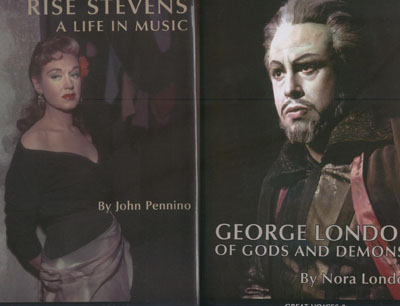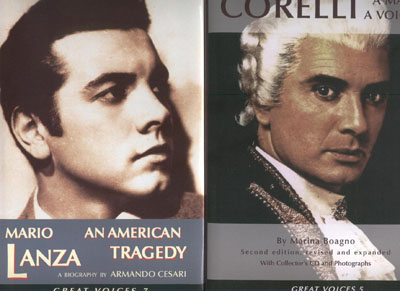



BASKERVILLE publications
www.baskervillepublishers.com
Of the four bios mentioned above, first prize should be given to Nora’s London’s “Of Gods And Demons”. This 154 page book is, in fact, a re-write of an earlier published book on her late husband and legendary baritone George London. This book can’t be recommended highly enough and because of its straighforwardness it is still one of the best books ever written about an opera singer. A sense of humanity prevails throughout and the narrative is immensely moving. Nora London doesn’t shy away from the difficulties of her husband’s youth, the health problems with his voice that ended his singing career prematurely or his very tragic last years. The book has a selective chronology and a fine discography and videography compiled by Robert Baxter. An extra bonus is the included CD which documents the most important stages of London’s career in mostly previously unavailable recordings from 1948 (his first 78rpms) to 1963 (his Bolshoi Boris).
Readers of the Rise Stevens’s biography can be assured that the account they are about to enjoy will be accurate, well-documented, perceptive and entertaining. That’s how the late Astrid Varnay judged John Pennino’s book on the legendary American mezzo soprano. After reading the book myself I can’t agree with her fully. A big drawback for this reader is that this 416 page book does not have an index. Minor quibbles include some typos (Rosekavalier pg.332) and the fact that Pennino is too kind (he’s obviously a fan) when discussing her recorded legacy. (PAGE 333 on her DALILAH)
The discography is as perfect as can be and there are several wonderful photographs.
Several books have been written about Mario Lanza and they all have merits. This latest addition by Armando Cesari is valuable also and every Lanza fan should get it.
Nevertheless, for the general reader the Derek Mannering book will suffice.
Cesari gives us a wonderful discography, great pictures and a few new insights but throughout the narrative he remains too much of a fan. Cesari dismisses, a bit too easily, all previous Lanza biographers as musically incompetent and unable to do justice to their subject. One wonders if musical competence means praising every single note Lanza sang at the expense of every other tenor of his era. I mean as long as you like Lanza you belong to the ‘cognoscenti’ (see back cover). If however you’re a bit too critical, as the late Boris Goldovsky was, you’re subject to Cesari’s ‘dissing process’.
Several statements in the book are plainly annoying and sometimes Cesari is very selective with his sources. He constantly leaves out those that don’t fit into his conception of the subject. Absolutely ridiculous is Cesari’s statement that the legendary De Sabata desperately wanted Lanza for Chenier at la Scala. And while Cesari is otherwise eager to quote ‘sources’ this quote, not surprisingly, remains unsupported. Equally absurd is the statement attributed to Callas in which she describes Lanza as Caruso’s successor. A great redeeming factor is the inclusion of a CD which has much rare material previously unavailable on compact disc. The CD alone is a must for every lover of great tenor singing.
Revised and expanded editions don’t stir much enthusiasm for all the obvious and obligatory promotional reasons behind them. However, in the case of Mme Boagno’s revised and expanded Corelli edition expectations were heightened. The first edition was judged a total failure by almost every critic in the world and several fans alike (even Corelli didn’t like it) for lack of substance. The books only merit was a detailed chronology and discography.
In it the enigmatic personality of Corelli went from A to B and from there dragged on till C. He never gained contour as a person, we were never taken backstage in the kitchen of opera and he seemed to have been born at 30 years old and apparently never married. From this it is clear that a revised and expanded edition would be more than welcome. And indeed Boagno has added some 14 pages on Corelli’s first thirty years, which allows us to gain some idea of his youth in Ancona, but only in vague generalities. We finally get to know some family members, learn that he was in love with a petite brunette etc. And yes, he was in the military which is brushed in as a one liner with the immediate addition that he was drafted like anyone else and not politically involved. Boagno proves once again to be a champion in raising questions rather than answering them. For how long was he in the army? Where? When? In what function etc? There is again hardly anything on Loretta di Lelio, who was effectively his wife, manager, coach, cook and dominatrix. In short, despite the added chapter on his youth and some details regarding his post career life we’re still left with an incomplete, one-sided picture of Boagno’s idol and that is precisely where the book goes wrong again. Respect and pride of having obtained the honour of being his first biographer are dripping from every page, while the backstage fights with Loretta and colleagues, his mysterious private life and his difficult character are still hardly touched upon. I was surprised to see the photo section was not expanded as promised but greatly shortened (almost cut by half) while this new expanded edition turns out to be actually shorter than the original by a full ten pages.
Those who want the complete picture will have to wait until next year, when René Seghers’ lively and more accurate written biography will be published. When I consulted this author to make a pre-comparison possible he provided me with a short peek into his efforts and I must say I was very much impressed. Seghers promises us an array of unique unpublished Corelli material, a multifold of photographs of Corelli’s youth and all the names, details and backstage wheeling and dealing based on hard facts and direct sources.
See the links section for websites on Corelli, London and Lanza.
Rudi van den Bulck, Opera Nostalgia